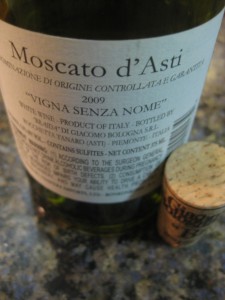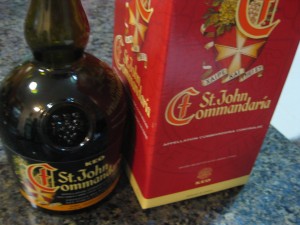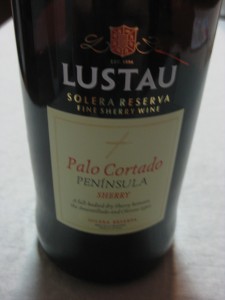 Moscato d’Asti is a semi-fizzy dessert wine if wine shops and their 15% off sales on “dessert wines” are to be believed. In my opinion, it barely qualifies as either. The wine is barely fizzy, although it has a few bubbles that sneak to the top of the glass like rogue spies. Perhaps they call it a dessert wine since it’s a sweet wine, and yes, it is sweet. But when I think of dessert wines, I think of high levels of alcohol to kick the night into full gear and well out of second gear. This wine, clocking in at 5.5% alcohol, puts that pre-gaming rush into the pitstop. This should be a pre-dinner wine for chocolate and sweet lovers who are easing into their meal, not the last stop before $1 pizza cravings kick in.
Moscato d’Asti is a semi-fizzy dessert wine if wine shops and their 15% off sales on “dessert wines” are to be believed. In my opinion, it barely qualifies as either. The wine is barely fizzy, although it has a few bubbles that sneak to the top of the glass like rogue spies. Perhaps they call it a dessert wine since it’s a sweet wine, and yes, it is sweet. But when I think of dessert wines, I think of high levels of alcohol to kick the night into full gear and well out of second gear. This wine, clocking in at 5.5% alcohol, puts that pre-gaming rush into the pitstop. This should be a pre-dinner wine for chocolate and sweet lovers who are easing into their meal, not the last stop before $1 pizza cravings kick in.
Taste
Even with my gripe on the misnomer, this wine delivers in all kinds of ways. There’s the bit of fizz that’s barely noticeable in the deadly flirty way that hands touch hands in movie theaters, and there’s the taste of moderate, refined flavors. Peach, rose and pear sprout in the nose, then there’s a whole lychee swimming pool that shows up in your mouth and some sage and herbs sprout after the lychee lagoon drains away. None are too overpowering, they’re just really different flavors that somehow pull together into a wine that defines its “dessert wine” label.
Grape
Think of Moscato (or Muscat) as the Abraham of wines. Pretty much all wines started with Abraham and then branched off from there (Ur being Piedmont, apparently) into all kinds of crazy Muscat-type wines. This particular wine is Moscato d’Asti (Muscat from Asti, up in Piedmont), which is made from the grape Moscato Bianco (“White Muscat”). I’m confused myself with all these Muscat names, but looking at the color of this wine (white) and where it’s from (Asti), the names are starting to make sense. Anyway, there are all kinds of wines that come from this Jacob-branch of the family, even other sparkling wines made from Moscato Bianco like Asti Spumante. Plenty of other Muscats exist on the Esau-side of the vini-family tree but it’s best to leave them for another day. Today’s all about Jacob and his Moscato Bianco.
Detail Up!
Moscato d’Asti 2009 Vigna Senza Nome
Random Googles
* “Muscat Blanc a Petits Grains” is French for “Moscato Bianco.” It goes by at least 10 other names, the best of which is “Muskateller.”
* Moscato Bianco is the oldest grape in Piedmont (that hambone chunk in the NW that bumps into France and Switzerland).
* Moscato d’Asti – first made by a wine-loving jeweler in the 1500s. Fact.

